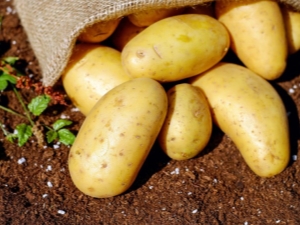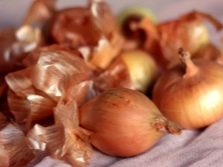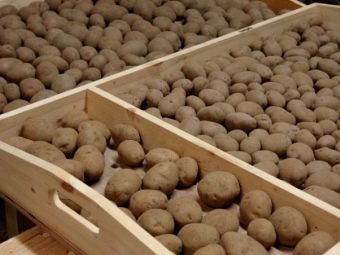Description and process of growing potatoes "Breeze"

In 2005, a new potato variety was bred by specialists in Belarus, which received the romantic name “Breeze”.In 2009, it was officially recognized by Russian gardeners and recommended for cultivation in northern and western areas. This variety is not inferior to foreign varieties and is characterized by a pleasant taste, ease of care and excellent immunity. Not surprisingly, she quickly won the love of vegetable growers across the country.
Characteristic
Potato "Breeze" refers to srednerannymi varieties: fruits are formed somewhere in three months after planting. The bush is quite tall and straight. The stem is thin and slightly faded. The resulting small flowers have a rich purple hue with a reddish tint. The plant has large dark green leaves with wavy edges. Tubers have a neat round shape, tiny eyes and smooth yellow skin. The flesh is also yellowish, and the color is not lost even during heat treatment.
The weight of one fruit on average is 130 grams, and the minimum - 97 grams. Taste of vegetables at the level - on this issue, the reviews say only positive. Starch is found in small quantities - approximately 12%. The tuber itself also looks attractive, which explains why Breeze is often grown for sale. The amount of the crop produced is quite satisfactory: a gardener can receive up to 450 centners of fruit per hectare of orchards (the average number is 300 centners, about 64.2 tons of fruits are collected per hectare). A record number was 625 centners, and they were collected in Belarus. Experts decided that such an outstanding event was due to the presence of nutrient soil.
The variety has good keeping quality and under proper conditions it can be stored for a long time. Finally, root crops effectively resist mosaic, cancer and scab, which indicates a high immunity. "Breeze" enjoys justified popularity and is actively used in cooking. Most often, this variety is chosen for the preparation of chips, french fries or frozen vegetable mixtures. With regard to deficiencies, experts say about the low resistance of the nematode and late blight. The tops of the plant are particularly affected.
Landing
The main method is planting with tubers. They are preselected at the end of the season and stored for storage in a cool room. A month before the intended planting, the tubers are germinated: the boxes are taken out in a warm place, or the potatoes themselves are wrapped in a polyethylene fabric. In addition, rotted and damaged samples are eliminated at this stage, and healthy ones are treated with a pink solution of manganese and growth stimulants.
At the two-week preparatory stage, the material is aged in a bright room at a temperature of 13 degrees. 3 or 4 days before planting, the tubers are covered with bags, so that they stand a little in the dark. So shoots will develop simultaneously. It is possible to plant potatoes only when the temperature of the soil reaches 8 degrees, and the heat is measured with a thermometer at a depth of 10 centimeters. This usually occurs in early May. Preliminary mineral fertilizers containing potassium and superphosphate are introduced into the soil, and then the soil is dug up. Earlier in the fall, you need to fertilize the beds with manure (about 3 kilograms per square meter) and dig up the soil. Potatoes will be planted in the depths of 10-12 centimeters.
Between the pits will need to leave a gap of 40 centimeters, and between the grooves themselves - approximately 70 centimeters.
Tubers are laid so that the already sprouted eyes are at the top. Above all, powdered with soil, fertilized with wood ash to protect the planting from diseases and pests. It is customary to use from 400 to 550 tubers per one hundred square meters of land (the heavier the soil, the smaller the quantity).Although this variety is usually propagated with the help of whole tubers, this can be done with the help of potato halves, seedlings, branches, and, of course, seeds. The root crop is stored for a long time, without losing its quality characteristics, under certain conditions: dryness, darkness and temperature, ranging from 2 to 5 degrees.
Care
Speaking of care, it can be noted that it is extremely simple. In any case, "Breeze" grows even in areas with a harsh climate, is not afraid of either drought or excessive moisture. But still worth a few simple recommendations to obtain a good harvest. Firstly, the plot must be well prepared, that is, the soil is cleared of stones and roots, including weeds. If you do not follow this, then the remaining weeds will “steal” nutrients and fluid.
Secondly, the soil should be regularly loosened. This is how oxygen comes to the root system. In the case when this procedure is not carried out, a dense crust is formed on the surface, “blocking” the flow of gas to the root crop. Loosening is usually carried out after irrigation with water. Thirdly, the "Breeze" requires regular and abundant watering. The amount of water largely influences how the potato will resist diseases and how it will eventually taste. However, too much water will play a bad joke: the potato does not like this soil too wet. It is necessary to focus on the condition of the soil: as soon as the drying out of the soil is detected, it is necessary to immediately water the tubers. After planting should not be watered, since there is still moisture in the ground after the snow melts. The first watering occurs two weeks after the emergence of the sprouts.
Fourth, the variety needs to be periodically fertilized, mainly with superphosphate and ammonium sulfate, which maintain normal soil acidity. This should be done at least once a year, and ideally two or three times. As an organic dressing, wood ash, humus and bird droppings are selected, which are diluted in water and infused under the plant root. Typically, organic matter acts as a preventive feeding, and minerals - if something wrong happens with the growth of a bush. Mineral fertilizers are applied by spraying from a spray bottle.
Two weeks before harvesting, it is recommended to trim the tops. It is believed that this accelerates the growth of the root. If the air and the earth are humid, then 80 days will pass from germination to “Day X”. If the ground and the air are dry, then it will take longer to wait. Fruit can not be stored in hot spaces, otherwise the shoots will begin to emerge ahead of time. In addition, it is better not to cover them. If the tubers are intended for further germination, it will be good to provide light to the seed. In the light of the buds are compacted, and seedlings become more active.
Diseases and pests
The “breeze” is extremely sensitive to the nematode parasite: it cannot grow in the garden occupied by this pest. In addition, potatoes can get scab and black leg. When immunity is weakened, a fungus is added to this list, in order to prevent which it is worth treating the bushes with fungicidal solutions. Another preventive measure is regular weeding. Also diseased late blight root crops can not be planted. The disease is very dangerous for the "Breeze", because it can carry more than half of the crop, deprive the seed material of immunity and eyes. You can find it by noticing the specks on the sprouts: black, brown and purple.
Scab is also treated with fungicides, and prophylaxis is carried out by introducing heterosis and planting maize on potato beds. Before planting, seed must be washed, and the affected areas are destroyed. Generally, scabs lose their taste and reduce starch content.
To combat these two diseases, you can use the tools "Acrobat" and "Ridomil Gold", when the trunk reaches 15 or 20 centimeters.
If the potato landing is attacked by the Colorado potato beetle, then onion peel will come to the rescue. Before planting, it is to be poured into the fossa, and then - with it, mulching. In addition, it is a good idea to plant beans between rows, calendula and mustard. The Taboo solution, in which the tubers are processed before planting, will also help prevent the onset of various pests, including the aforementioned Colorado potato beetle.
Recommendations
Reviews of gardeners allow you to learn a lot of useful information: from how to organize the storage of potatoes, before preparing the beds. Most of those who have tried this variety agree that the taste is excellent and the rate of ripening is quite high. In addition, the root is not boiled soft during cooking. The leaves are not curled, and the skin is easily removed. The fruits themselves are not very large, but after two months you can try the first vegetables. Although the tops usually mow down, some people neglect this advice, but still remain content. You can fertilize once, for example, at the beginning of autumn.
Yield "Breeze" depends on the condition of the soil. If the land is properly prepared and fertilized, the harvest will be high, and the potato will be very small in size. However, it happens that large potatoes ripen in which there are voids inside - this contributes to the rotting of the tubers. Fertilizing, by the way, can be ordinary humus - this will be enough. Bushes will not get sick if you care for the nightshade correctly.
After harvesting, it is worth drying for a couple of days, spreading it on the floor in a dry place where oxygen is provided. When the potato is dry, it can be laid out in wooden boxes and taken to the cellar. Permanent storage should be kept at a stable low temperature. It should also be prepared that early shoots may appear in winter - they will have to be eliminated. Otherwise, the "Breeze" will wither and become unsuitable for eating.
See why the seed potato is needed for postaki, see the following video.















































